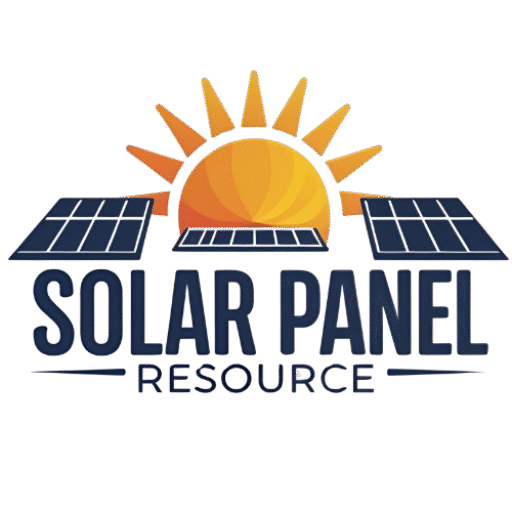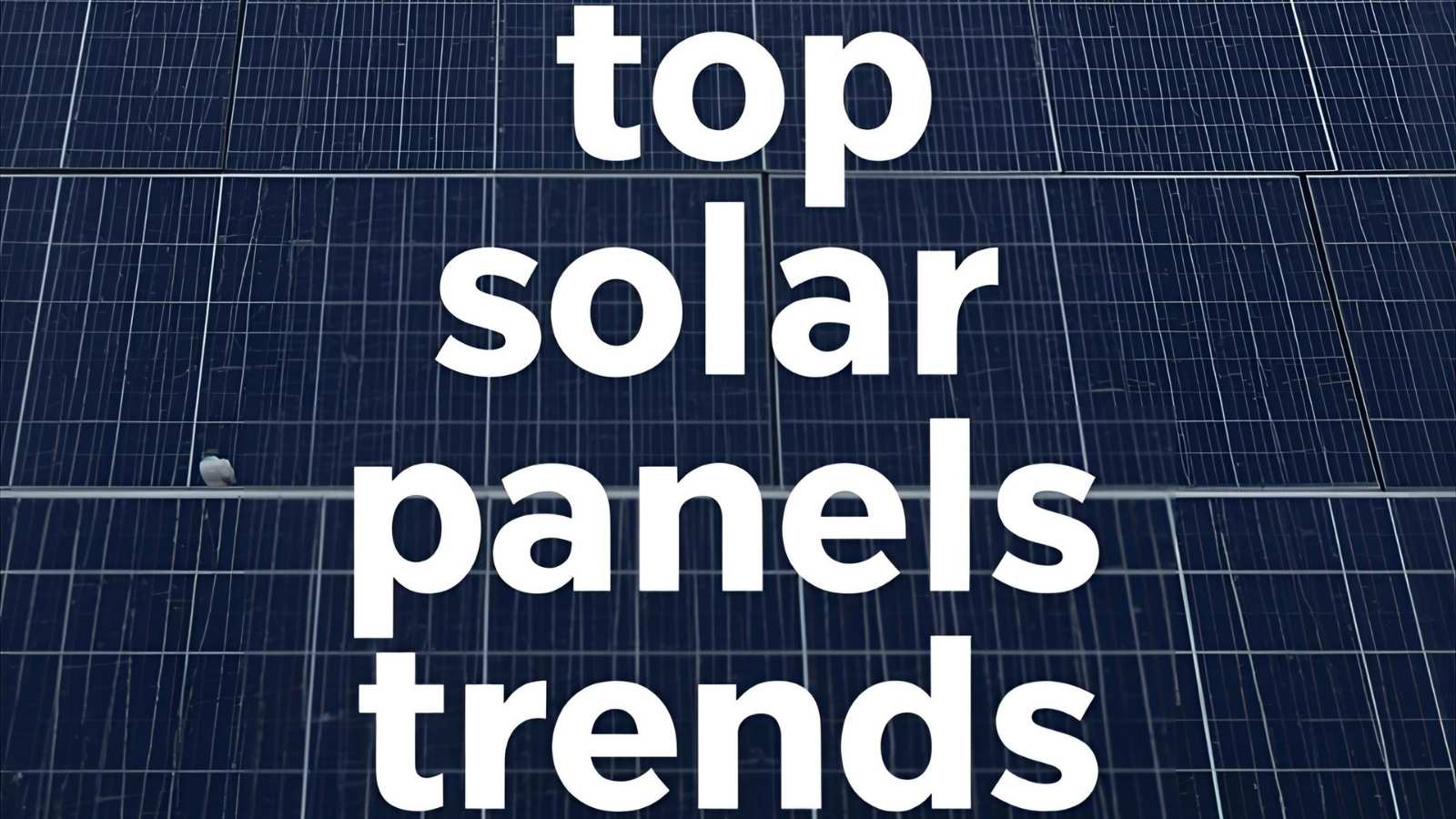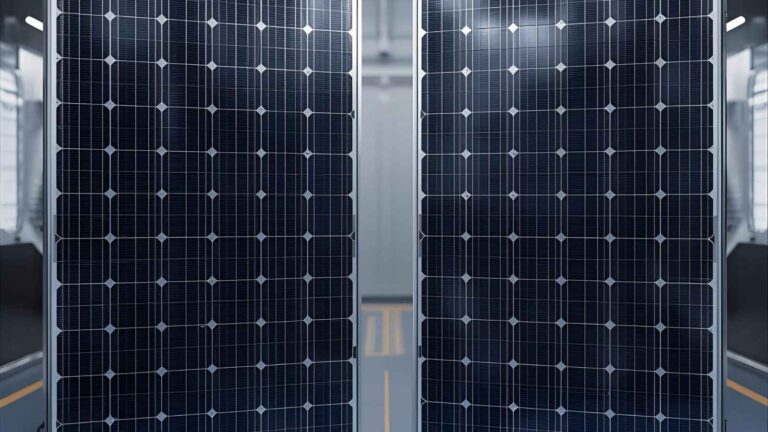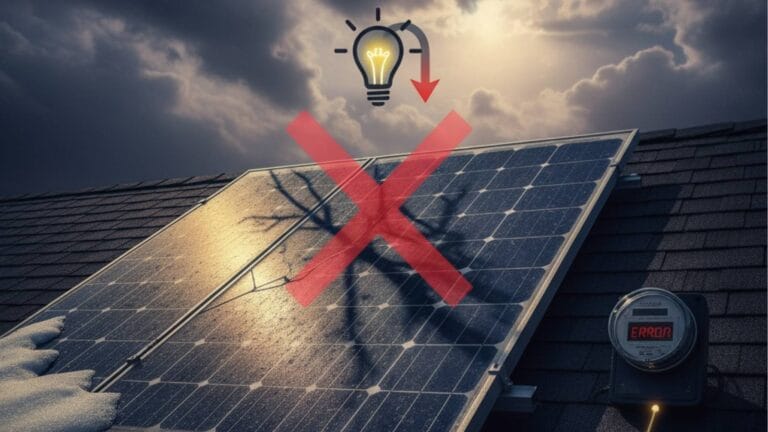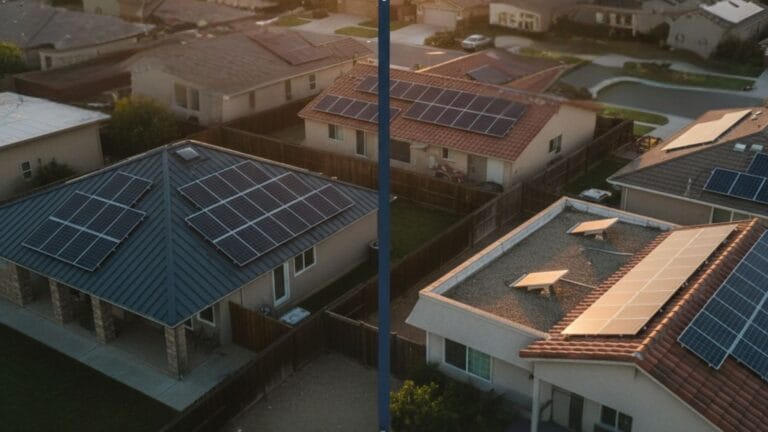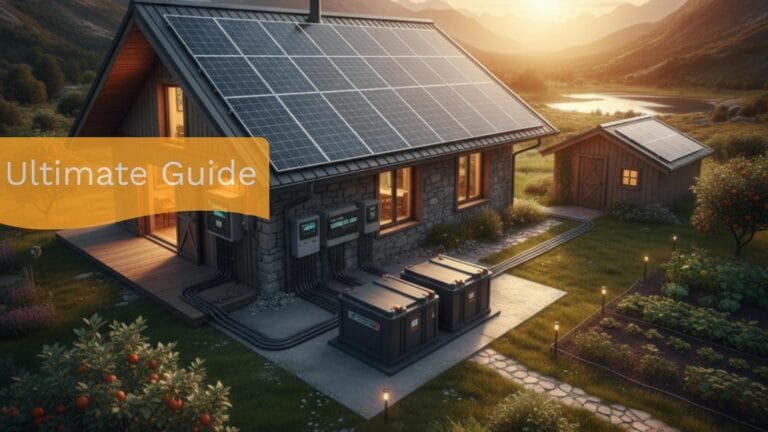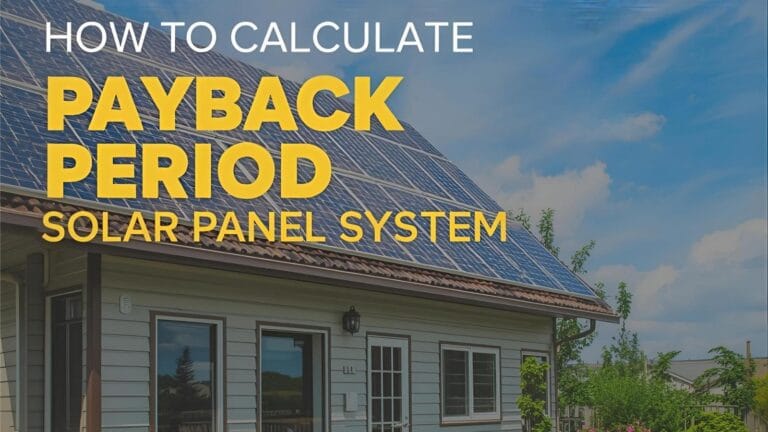Top Solar Trends According to Industry Leaders in 2025
In 2025, solar power has officially moved beyond a niche technology to become a dominant force in the global energy landscape. The trends are clear and the data is compelling, painting a picture of a sector defined by innovation, affordability, and rapid scale.
1. The Global Power Shift is Here
According to Ember’s 2025 Global Electricity Review, the world reached a historic milestone in 2024, with low-carbon sources supplying over 40% of the world’s electricity for the first time since the 1940s. Solar power is the primary driver of this shift, having maintained its exponential growth and doubling its total generation in just three years. This isn’t just about statistics; it’s a fundamental change in how the world is powered, with clean energy sources now directly displacing fossil fuels in the electricity mix.
2. China’s Manufacturing Engine
The explosive growth of solar has been made possible by China’s immense manufacturing scale and commitment. China’s solar PV manufacturing capacity exceeds 80% of the global total across all stages of the supply chain. This has led to a steep decline in module prices, making solar power the most affordable form of electricity in many parts of the world. While this reliance creates some vulnerabilities, it has also democratized access to solar technology, accelerating its adoption at an unprecedented rate worldwide.
3. The Era of Smart Solar
Today’s solar industry is about more than just panels. It’s about seamless integration with other technologies to create a resilient and optimized energy system.
Digital Optimization: The solar revolution is also being fueled by digital innovation. Artificial intelligence (AI) and advanced analytics are being used to optimize everything from the manufacturing process and supply chains to the real-time performance of solar farms. These digital tools ensure every electron is used efficiently and that the grid remains stable, even with a massive influx of renewable energy.
Storage is Key: The rapid expansion of solar is now being matched by accelerating deployment of grid-scale battery storage. This solves the intermittency problem of solar, allowing energy generated during the day to be used at night, which is crucial for balancing the grid and ensuring a consistent power supply.
Reference: Ember – Global Electricity Review 2025
What is the downside of solar panels?
While solar power has emerged as a cornerstone of the global energy transition, it’s not without its challenges. These are not insurmountable problems, but rather system-level constraints that require careful management with both technology and smart policy. A professional, data-driven perspective reveals these key areas of focus.
1. Managing Intermittency: A Daylight-Bound Resource
Solar’s primary constraint is its dependence on sunlight. This means it only generates power during the day and its output fluctuates with weather conditions. This is measured by the capacity factor, which shows how much energy a power plant actually produces compared to its maximum potential. Solar’s capacity factor is significantly lower than dispatchable sources like nuclear power, with recent U.S. figures showing solar at around 23% compared to nuclear at approximately 92%.
The solution to this lies in two key areas: energy storage and demand flexibility. As battery costs continue to fall rapidly—with the global benchmark cost for battery storage dropping by a remarkable 33% in 2024—it is becoming increasingly economical to store solar energy for use after sunset. Additionally, smart grid technologies and policy can encourage energy consumption during peak solar production hours.
2. Grid Integration & Curtailment: The High-Penetration Challenge
As solar power is deployed on a massive scale, it can sometimes overwhelm the grid’s ability to absorb it. This leads to curtailment, where grid operators must intentionally reduce solar output to prevent an imbalance. While it may seem counterproductive, curtailment is a necessary step to maintain grid stability.
This is a problem that is being actively managed. With falling costs for battery storage and new technologies that can better forecast and manage energy flows, grid operators can absorb more and more solar power without waste. Furthermore, smart grid infrastructure and updated regulations are key to ensuring that high-solar regions can continue to add capacity without risk.
3. End-of-Life Management: A Growing Challenge
Solar panels have a long lifespan, but they aren’t immortal. As the first wave of installations nears its end, the industry must develop a sustainable plan for EoL management. While the economics in many jurisdictions still favor landfilling, the technology for recycling is advancing rapidly. The EU’s WEEE directive has set a precedent with its extended producer responsibility (EPR) framework, which holds manufacturers accountable for the collection and recycling of their products.
U.S. pilot lines have already demonstrated the ability to recover more than 90% of a panel’s materials. The focus now is on improving the recovery of critical materials and establishing a robust, globally harmonized system to prevent a future waste problem and create a new source of raw materials.
4. Quality and Safety: A Matter of Standards
The safety of a PV system is highly dependent on the quality of its design, installation, and components. While PV systems are generally safe, poor practices can lead to risks like arc faults and fire. The IEA PVPS Task 13 provides detailed documentation on common failure modes, such as faulty terminations and incompatible connectors.
This is why professional installation and ongoing maintenance are so critical. By adhering to international standards (e.g., UL, IBC/IFC) and trusting a certified professional, you can ensure that your system is not only generating power efficiently but also operating safely for its entire lifespan.
Choosing the right roof type can significantly improve system performance — see our guide on the best roof types for solar panels.
Do solar panels really make a difference?
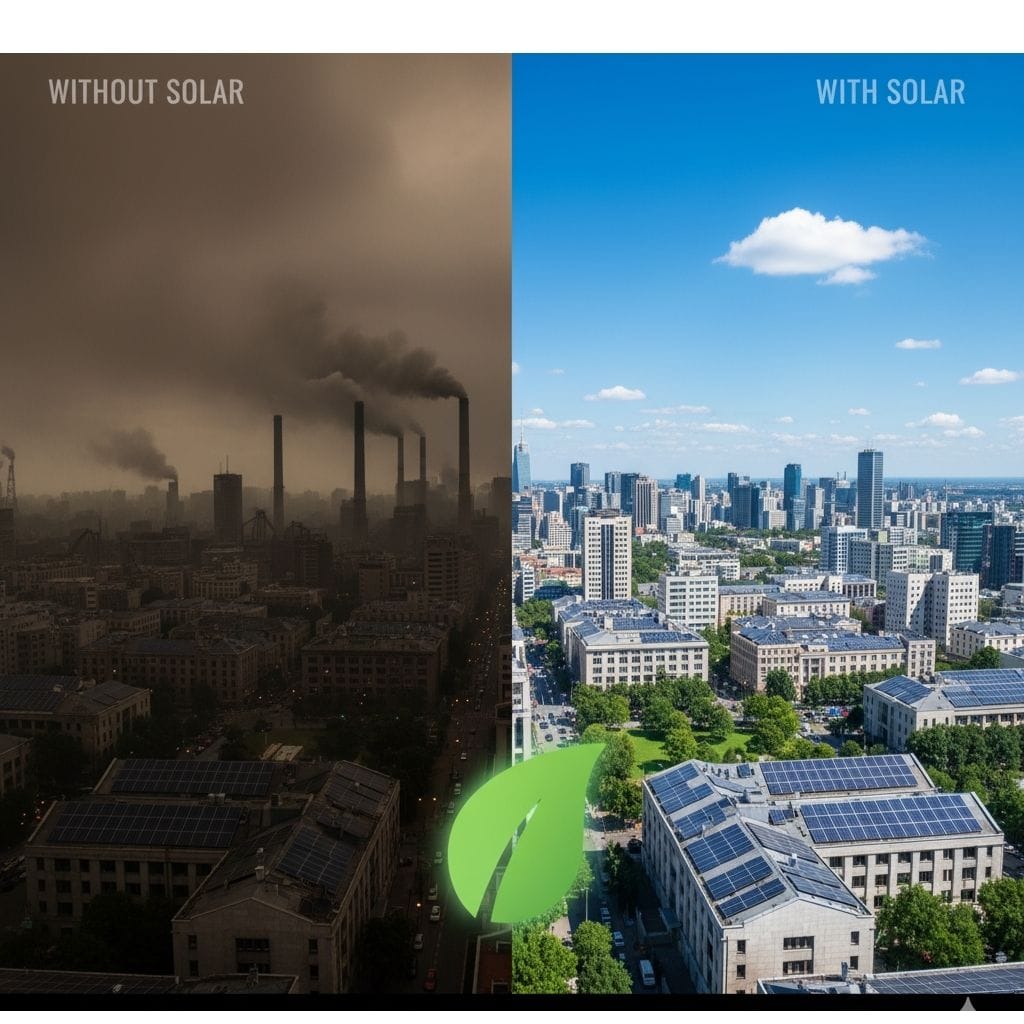
Yes—solar power is driving the decarbonization of the global electricity grid and making energy systems more resilient.
A New Era of Global Electricity
The data is clear: we are in the midst of a historic shift in how the world is powered. In 2024, renewables supplied a record 32% of global electricity, with solar power as the largest single contributor to that growth. According to Ember’s Global Electricity Review, low-carbon generation (renewables plus nuclear) reached a historic 41%, structurally displacing fossil fuels from the energy mix. Solar’s record growth is a testament to its affordability and scalability, and its rapid deployment is a primary engine of the global energy transition.
Measuring Solar’s Decarbonization Impact
The environmental benefit of solar power depends on where it’s installed. On a grid dominated by coal or natural gas, solar has a massive decarbonization impact. On a typical U.S. grid mix, each megawatt-hour (MWh) of solar energy that displaces average generation avoids about 0.81 lbs of CO₂ per kWh (or about 0.37 tCO₂ per MWh).
However, on a grid that already uses a lot of clean energy (like hydropower or nuclear), the carbon savings per MWh are lower. To get the most accurate picture, experts use region-specific data and factors to reflect the actual energy sources being displaced. The EPA’s eGRID for the U.S. and similar reports from the IEA and JRC for other regions are the gold standard for this type of analysis.
Solar and Storage: The Resilient Power Duo
Beyond reducing emissions, solar and battery storage are fundamentally changing how the grid operates, making it stronger and more reliable.
A Central Planning Resource: Data from organizations like NREL highlights that the pairing of solar and storage is no longer just a trend—it’s a central planning resource for utilities through 2030 and beyond. This integrated approach helps stabilize the grid and reduces our exposure to fuel price shocks, creating a more secure and predictable energy future.
Improving Resilience: The combination of distributed rooftop solar and utility-scale solar, paired with battery storage, improves grid resilience by reducing peak loads and providing backup power during outages. This is especially valuable as it reduces reliance on expensive, fossil fuel-powered “peaker plants” that are only brought online during high-demand hours.
How much money will I save if I install solar panels?
Determining the financial viability of a solar investment is complex, as it’s a highly site-specific calculation. The payback period—the time it takes for your energy savings and incentives to equal the system’s upfront cost—is the most critical metric. Here’s a breakdown of what influences it, according to the latest market data and expert analysis.
1. The Core Calculation: Payback Period
In 2025, a residential solar system in the U.S. commonly achieves a simple payback of 6–10 years. This wide range is a direct result of several key variables. A homeowner in a location with high electricity prices and strong solar irradiance (e.g., California) will see a much faster payback than a homeowner in a region with low electricity costs and less sunshine. For commercial properties, which often have higher energy consumption, the payback period is typically 8–12 years, although this can be shorter if they are able to significantly reduce demand charges.
2. The Power of Incentives: The U.S. Federal Tax Credit
The single most influential factor in solar economics is the U.S. federal tax credit, also known as the Residential Clean Energy Credit. This credit allows you to deduct 30% of your system’s total cost from your federal taxes. The credit is available for systems installed through the end of 2032, after which it will step down to 26% in 2033 and 22% in 2034. Without this substantial incentive, the average payback period for a residential solar system would lengthen notably, making the financial case much weaker.
What Drives Savings? A Deeper Look
A solar system’s ability to generate savings is driven by a combination of factors:
- Self-Consumption Rate: This is the percentage of solar energy you produce that you use in your own home in real time. The more you use, the more you save by avoiding buying electricity from the grid.
- Net Metering vs. Net Billing: Your utility’s policy dictates the value of your excess energy. Net metering gives you a full retail credit for every kWh you export, while net billing provides a lower, wholesale-rate credit. The former can significantly shorten your payback period.
- Time-of-Use (TOU) Arbitrage: For homes with batteries, this is a game-changer. You can store your solar energy during the day and use it during the evening, when grid electricity is most expensive. This strategic energy usage, known as arbitrage, can dramatically increase your savings.
The Bottom Line: A Robust Financial Investment
The solar industry has seen steep cost declines in recent years, particularly in solar modules and battery storage. This has made solar a more robust investment than ever before. With today’s module prices and still-favorable incentives, solar remains a powerful hedge against rising and volatile retail electricity prices. However, a proper financial analysis must always be site-specific, using current local tariffs and incentives to provide an accurate model of your potential savings.
What is the biggest risk of solar panels?
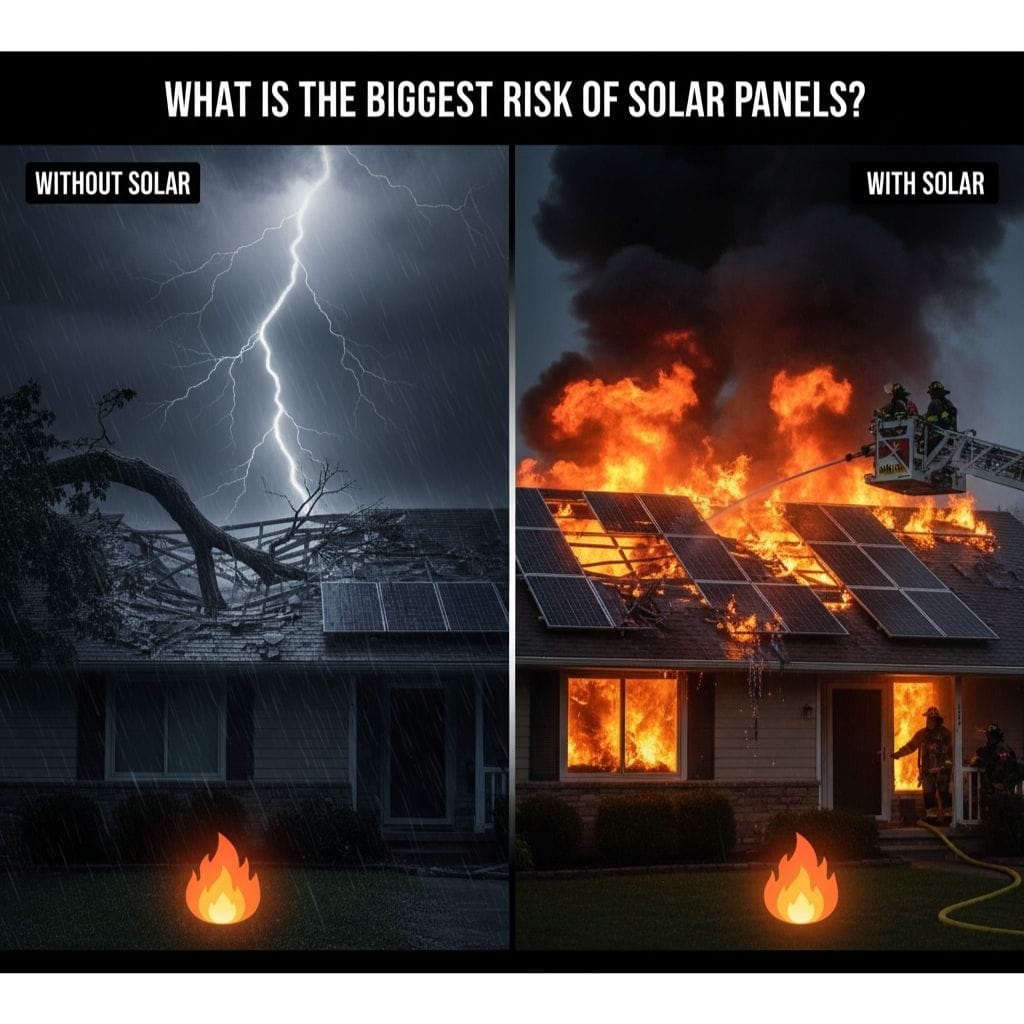
An investment in solar power, particularly a complex system with battery storage, requires a clear-eyed view of potential risks. Professionals categorize these risks into four key areas. The good news is that these are well-understood challenges with straightforward and effective mitigation strategies.
1. Financial & Market Risk
This category is about the return on your investment. The primary risk is that changes to local policies could impact your system’s profitability. A major example is a shift from net metering (where you get a full retail credit for exported solar energy) to net billing (where you get a lower, wholesale-rate credit). Additionally, issues with interconnection queues and utility approvals can cause project delays, adding unexpected costs.
- Mitigation: The best defense is a thorough, data-driven financial analysis before you sign a contract. Your solar professional should model your system’s economics based on current and potential future policy scenarios. It’s also critical to choose a reputable installer with a proven track record of navigating local utility requirements.
2. Technology & Supply Chain Risk
As the solar market grows, so do the risks associated with component quality. Inverters, in particular, have a shorter lifespan than panels and will likely need to be replaced. Additionally, the proliferation of different connectors and components from various manufacturers introduces the risk of cross-mating, which can lead to safety and performance issues.
- Mitigation: Insist on certified equipment from trusted, Tier 1 manufacturers with strong warranties. This provides a guarantee of both quality and a clear path for replacement if something fails. Your installer should also use components that are compatible and sourced from a reputable supply chain.
3. Project Execution Risk
A solar system is only as good as its installation. Errors made during design and installation are a leading cause of long-term failures and safety hazards. Common issues documented by organizations like IEA PVPS include incorrect wiring terminations, improper cable management, and poor weatherproofing. These can lead to system underperformance or, in extreme cases, damage.
- Mitigation: The solution here is to demand qualified installers and a well-documented process. Your installer should provide a clear design, use professional cable management, and adhere to a documented inspection and testing schedule, including infrared (IR) scans to check for hot spots. This ensures the system is installed correctly and safely from day one.
4. Safety Risk
The two main safety risks come from high-voltage DC wiring and battery storage. In a typical solar setup, the DC wiring that runs from your panels to your inverter is “live” whenever it’s exposed to sunlight, posing a risk of arc faults and fire. For systems with batteries, the primary safety concern is thermal runaway, a dangerous chain reaction that can lead to fire.
Mitigation: For rooftops, look for systems with rapid shutdown compliance (a requirement in many regions) and Module-Level Power Electronics (MLPEs) like micro-inverters or power optimizers, which convert DC to safer AC power at each panel. For battery systems, insist on certified hardware that includes advanced fire detection and suppression, as well as robust thermal management and proper ventilation. Regular professional inspections and firmware updates are also critical for mitigating these risks.
What is more efficient than solar panels?
Navigating the world of energy requires moving beyond a single definition of “efficiency.” When we talk about different power sources, “efficiency” can refer to a number of technical and economic metrics. A professional understanding of the energy landscape considers a blend of these factors to build a resilient and cost-effective grid.
1. The Many Meanings of “Efficiency”
The term “efficiency” has multiple meanings in the energy world. A solar panel’s conversion efficiency (e.g., 22% of sunlight converted to electricity) is a different metric from a plant’s capacity factor, which measures how often it actually operates. A nuclear plant, for example, has a high capacity factor, typically exceeding 90%, as it can operate continuously. In contrast, solar’s capacity factor is lower, as it only generates power when the sun is out.
2. A Portfolio Approach to Power Generation
No single energy source can meet all of the grid’s needs. The key to a modern, decarbonized grid is using a complementary portfolio of technologies, each with its own strengths:
- Solar PV for Daytime Power: Solar is incredibly cost-effective and provides a perfect match for daytime electricity demand.
- Wind for Shoulder Seasons: Wind turbines often produce the most energy during the “shoulder” seasons of spring and fall, complementing solar’s summer output.
- Firm, Low-Carbon Sources for Reliability: Consistent, reliable power sources like nuclear, hydropower, or geothermal act as the grid’s backbone, providing continuous power for reliability.
- Storage to Shift Energy: Battery storage is the ultimate flexibility tool, allowing energy from solar and wind to be stored and used whenever it’s needed, even at night.
3. Cost and Value: A Look at the Economics
While other technologies may have a higher capacity factor, solar PV’s low cost and modularity have made it the dominant force in the energy transition. According to industry tracking by BNEF, benchmark utility-scale PV remains the least-cost new build option in many regions, with module prices experiencing significant step-downs in 2024 due to global oversupply.
Even with its high cost in the past, Concentrated Solar Power (CSP) has become more economical, with the Levelized Cost of Energy (LCOE) falling by approximately 70% since 2010. This is due to larger plants and higher-capacity thermal storage, which allows it to deliver power during evening peaks, providing a direct complement to solar PV’s daytime production.
How many solar panels to power a house?
Getting the right solar system size is the single most important decision you will make. An undersized system won’t meet your energy needs, while an oversized one is a waste of money. A professional approach to sizing considers more than just a quick calculation; it’s a strategic process that involves understanding your current usage and planning for the future.
1. The Starting Point: Your Energy Baseline
The foundation of any solar system design is your household or business’s energy consumption. You should provide your installer with at least 12 months of utility bills to get an accurate picture of your usage patterns. In 2025, the average U.S. home uses around 855 kWh per month, but this can vary wildly based on climate and lifestyle. By analyzing your bills, a professional can determine your daily and monthly averages and, most importantly, identify seasonal peaks (e.g., in the summer for air conditioning).
2. The Core Sizing Formula: From Consumption to Panels
Once your energy baseline is established, the core sizing calculation is straightforward but requires expert input. The formula is:
Annual kWh Consumption ÷ Specific Yield (kWh per kWp) = Required System Size (kWp)
The “specific yield” is a crucial metric that accounts for your local solar resource. It’s an estimate of how many kilowatt-hours a 1-kilowatt-peak (kWp) system will produce in your specific location per year. In the U.S., this typically ranges from 1,300 to 1,700 kWh per kWp. For an average home consuming ~10,260 kWh annually, this works out to a required system size of roughly 6–8 kWp, or about 15–20 panels (assuming 400-watt modules).
3. The Sizing Strategy: Thinking Beyond Today
A smart solar investment is one that plans for the future.
- Reduce Load First: Before sizing your system, it’s often more cost-effective to reduce your energy consumption. Simple upgrades like a heat-pump water heater, induction stove, or better insulation can dramatically shrink your energy needs, allowing you to install a smaller, less expensive solar system.
- Factor in Future Loads: Are you planning to buy an electric vehicle (EV), install a heat pump, or electrify your home in the next few years? These new appliances will significantly increase your energy consumption. By adding “headroom” to your system now—perhaps an extra 2–4 panels—you can avoid the hassle and expense of re-permitting an expansion later.
- Consider Battery Pairing: While not necessary for a basic grid-tied system, a battery (typically 7–13.5 kWh for a single home) can dramatically improve your financial returns, especially in regions with poor net metering. It allows you to use your own solar power at night, reducing your reliance on the grid and maximizing your savings.
Are solar panels a good investment?
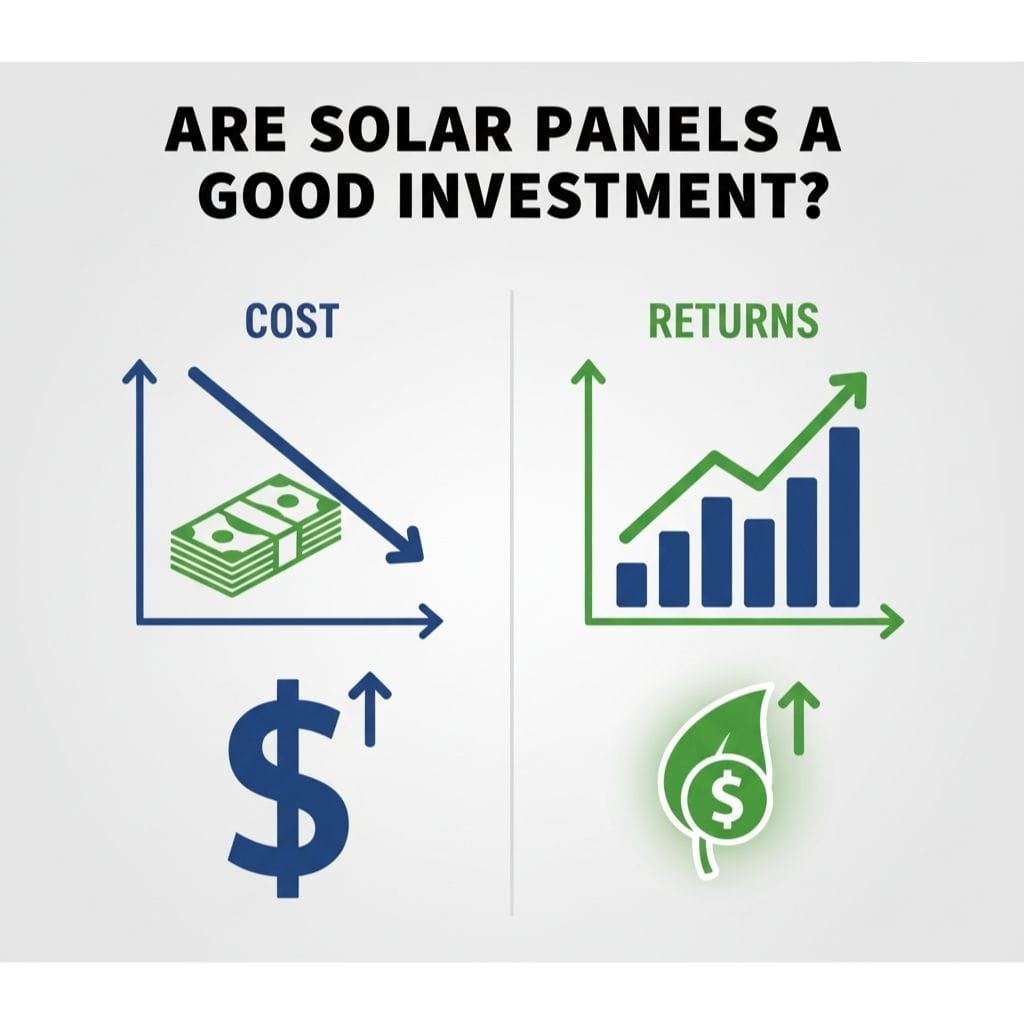
or most households and many commercial sites in 2025, yes—investing in solar power is a robust financial decision, provided your site, roof, and local policies are favorable. The total cost of ownership has never been better, and the long-term value continues to strengthen.
A Strong Financial Case
The case for solar has evolved from a niche environmental choice to a mainstream financial decision. According to independent analyses from experts like BloombergNEF and NREL, solar’s competitiveness is poised to last through the decade. This is driven by three key factors:
- Falling Costs: In 2024, the solar industry saw dramatic price declines. Module prices fell sharply due to a global supply glut, and battery storage costs dropped by an average of about 33%. This makes the initial investment more accessible and improves the overall return on investment (ROI).
- Long-Term Hedging: A solar system is a powerful hedge against utility rate volatility. By generating your own power, you are locking in a portion of your electricity costs for the system’s 25-year-plus lifespan. This provides a degree of financial certainty that you can’t get from relying solely on grid power, which is subject to unpredictable rate increases.
- Durable Technology: Today’s equipment is more reliable than ever. With performance warranties of 25 years or more, you can be confident that your system will produce clean, cost-effective energy for decades.
Key Drivers of Your Return
While the overall trend is positive, your specific ROI is driven by a few critical factors:
- High Retail Tariffs: The higher your local electricity rates, the more money you save for every kilowatt-hour your system generates. In areas with high Time-of-Use (TOU) tariffs, a solar system with a battery can be even more profitable, as it allows you to store cheap daytime solar power and use it to avoid expensive peak-hour rates.
- Self-Consumption Optimization: The most valuable electron is the one you don’t have to buy. Using solar energy as it’s being generated—for example, running your washing machine during the day—directly reduces your utility bill.
- Favorable Policy: Policies like net metering or net billing are essential for solar economics. These policies determine the financial value you receive for any excess energy you send back to the grid. A favorable policy can dramatically shorten your payback period.
The Expert’s Advice: Model with Confidence
To get a clear picture of your investment, it’s essential to perform a detailed, site-specific analysis. Your financial model should be conservative, using realistic assumptions for:
- Export prices: Don’t assume you’ll get a full retail rate for your exported energy forever. Model with conservative export values to account for potential policy changes.
- Degradation: All solar panels slowly lose efficiency over time. A professional model should factor in a typical degradation rate of 0.4–0.6% per year.
- Policy changes: Stress-test your model against potential policy shifts. For example, what would happen if your utility switched from net metering to net billing?
By working with a reputable installer who provides a transparent financial model and high-quality, certified equipment, you can be confident that solar is not only a smart environmental choice but a sound financial one as well.
Is it safe to live next to solar panels?
Understanding the safety of solar technology is crucial for any homeowner. The risks associated with PV systems are real, but they are also well-understood and effectively managed by modern safety standards and professional installation practices.
1. Fire Risk: Low but Not Zero
The risk of a solar system fire is extremely low—affecting less than 0.01% of all installations—but when an incident occurs, it is almost always due to improper installation, not a faulty panel. Fire risk is most commonly tied to the Balance of System (BOS) components, such as wiring, connectors, and inverters.
- Cause: Incident analyses show that most fires are caused by arc faults, which occur when a high-voltage direct current (DC) “jumps” across a gap in a broken or improperly connected wire, creating intense heat. Other risks include hot spots from manufacturing defects or debris, and poorly installed equipment.
- Mitigation: The solution is to insist on a certified and qualified installer who adheres to strict codes and standards. This includes using certified hardware (UL 1703, UL 1741, UL 2703), ensuring all components are compatible, and following best practices for cable management. A professional will also install modern safety devices like arc fault circuit interrupters (AFCIs) and rapid shutdown systems, which de-energize the panels to protect first responders.
2. Battery Safety: A Critical Consideration
For hybrid systems with batteries, the primary safety concern is thermal runaway, a dangerous chain reaction that can lead to fire. This is a rare event, but it is a serious risk that requires a professional approach.
- Mitigation: The industry has developed robust safety measures for batteries. Insist on a system with multiple layers of protection, including:
- Certified Hardware: Choose battery systems that have been certified by independent labs and meet all fire and electrical codes.
- Physical Protection: Batteries should be installed in a well-ventilated location with proper clearances and physical protection to prevent damage.
- Active Monitoring: Modern battery systems have a sophisticated Battery Management System (BMS) that constantly monitors the battery’s temperature, voltage, and health, and will shut the system down if a problem is detected.
3. Electromagnetic Fields (EMF): A Minor Concern
Concerns about EMF from inverters and cabling are common, but they are not supported by the data. Inverters do produce extremely low-frequency (ELF) EMF, but the levels fall well within the exposure guidelines set by leading health organizations.
Expert Consensus: According to the World Health Organization (WHO) and other health agencies, the EMF levels from residential solar systems are far below established limits and are considered safe for the general public. The EMF from an inverter is comparable to that of other household appliances, and the fields from the wiring are negligible.
Common myths vs. facts (2025 update)
Many common misconceptions about solar power persist, but a look at the data and the reality on the ground tells a very different story. Here’s a professional, human-written breakdown of the facts behind the most common myths.
Myth 1: “Solar is too small to matter.”
Fact: Solar is now a major player in the global energy market. In 2024, solar generated approximately 6.9% of all global electricity. More importantly, its growth trajectory is staggering. According to industry projections, solar is on track to temporarily surpass nuclear output during peak months of 2025 in key regions. This isn’t a small-scale, niche technology anymore; it’s a fundamental part of the global energy mix and a primary engine of the transition to clean energy.
Myth 2: “Solar panels never pay back the cost.”
Fact: The financial case for solar has never been stronger. In the U.S. in 2025, a typical residential solar system has a payback period of around 6–10 years. This timeline has been accelerated by two major factors: the 30% U.S. federal tax credit and the dramatic drop in the cost of solar modules and battery storage. With module prices continuing to fall and utilities facing rising electricity rates, a solar system is a robust financial investment and a powerful hedge against future energy price volatility.
Myth 3: “Solar panel recycling isn’t possible.”
Fact: The technology for solar panel recycling is not only possible but is already being implemented on a large scale. While the process is still maturing, recycling process chains can already recover valuable materials like glass, aluminum, and silver. Pilot lines have demonstrated that it is technically feasible to recover up to 92% of a panel’s materials. The main hurdle today isn’t technical feasibility; it’s economic viability. As more panels reach their end-of-life and regulatory frameworks like the EU’s Extended Producer Responsibility (EPR) mandate recycling, the economics of the process will improve significantly.
Myth 4: “Panels don’t work in winter.”
Fact: Solar panels work more efficiently in cold, sunny conditions than they do in extreme heat. The myth that panels shut down in winter is false. The overall drop in energy production during winter is due to shorter daylight hours and a lower sun angle, not a loss of efficiency. In fact, a cool, clear winter day can be one of the most productive times of the year. Furthermore, modern panels are designed to shed snow naturally, and a steep installation angle and regular maintenance can minimize winter-related losses.
The evidence is clear: 2025 is a landmark year for solar. It’s a year of scale, maturity, and integration, moving the technology from an alternative to a central component of the global energy mix. For anyone considering solar, a professional approach is essential to secure durable financial and environmental returns.
A Maturing Market of Unprecedented Growth
The solar industry has reached a new level of maturity. This isn’t a speculative market anymore; it’s a proven solution. Evidence from global reviews and reports shows solar’s rapid growth and improving economics. For businesses and homeowners, the total cost of ownership for a PV system is better than ever, driven by steep cost declines in modules and energy storage. This allows for the widespread adoption of robust, integrated PV-plus-storage systems. As a decision-maker, this means you can invest with confidence, knowing the technology and its financial model are supported by a decade of real-world data and falling costs.
Navigating with Expertise and Trust
While the overall outlook is positive, the success of your specific project depends on careful planning. A trustworthy and experienced professional is your most valuable asset. They will guide you through the complexities of:
- Sizing with Realistic Yields: A pro won’t just guess your energy needs. They will use site-specific data to model your system’s output, accounting for variables like sun exposure, shading, and local climate. This ensures you get a system that’s right-sized for your consumption.
- Modeling Financial Returns: The financial viability of solar is highly sensitive to policy. A professional will model your project’s payback under different scenarios, including potential changes to net metering and other local incentives. This gives you a clear and honest picture of your investment.
- Ensuring Safety and Quality: The solar industry has robust safety frameworks. Professionals follow established codes and best practices from organizations like IEA PVPS to ensure a high-quality, safe, and reliable installation. This mitigates project execution risks and ensures the system operates safely for decades.
The Bottom Line: Solar is a Durable Investment
By focusing on a well-designed system, professional installation, and a transparent financial model, you’re not just buying solar panels—you’re securing a long-term hedge against rising energy costs and investing in a sustainable future. The data shows solar’s global share will continue to expand, making it an increasingly valuable asset for both homeowners and businesses.

Solar Energy Enthusiast & Renewable Energy Researcher
Vural’s journey into solar energy began four years ago, driven by frequent power outages and high electricity bills at his own home. He has since gained hands-on experience with both personal and commercial solar projects. At solarpanelresource.com, Vural shares his real-world insights and in-depth research to guide homeowners and business owners on their own path to energy independence.
